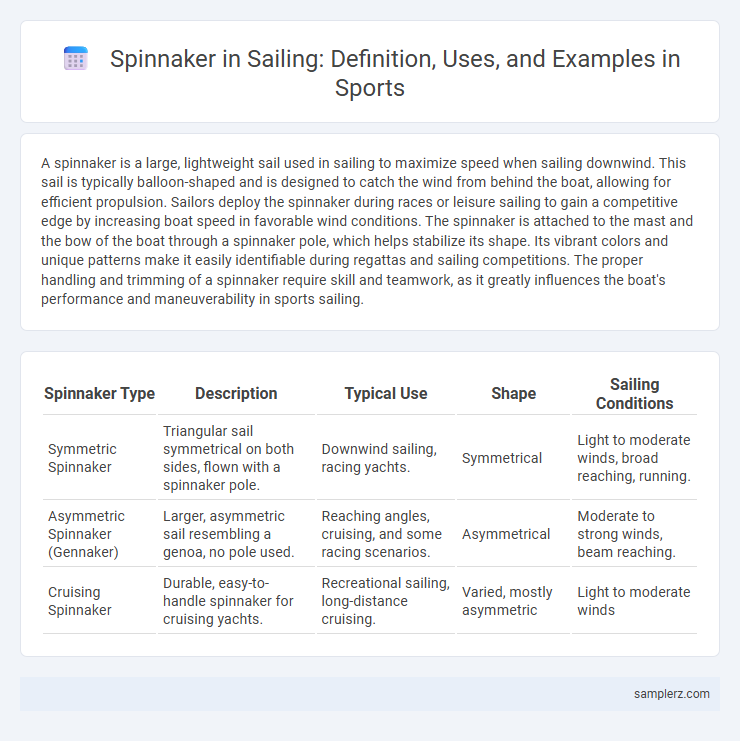A spinnaker is a large, lightweight sail used in sailing to maximize speed when sailing downwind. This sail is typically balloon-shaped and is designed to catch the wind from behind the boat, allowing for efficient propulsion. Sailors deploy the spinnaker during races or leisure sailing to gain a competitive edge by increasing boat speed in favorable wind conditions. The spinnaker is attached to the mast and the bow of the boat through a spinnaker pole, which helps stabilize its shape. Its vibrant colors and unique patterns make it easily identifiable during regattas and sailing competitions. The proper handling and trimming of a spinnaker require skill and teamwork, as it greatly influences the boat's performance and maneuverability in sports sailing.
Table of Comparison
| Spinnaker Type | Description | Typical Use | Shape | Sailing Conditions |
|---|---|---|---|---|
| Symmetric Spinnaker | Triangular sail symmetrical on both sides, flown with a spinnaker pole. | Downwind sailing, racing yachts. | Symmetrical | Light to moderate winds, broad reaching, running. |
| Asymmetric Spinnaker (Gennaker) | Larger, asymmetric sail resembling a genoa, no pole used. | Reaching angles, cruising, and some racing scenarios. | Asymmetrical | Moderate to strong winds, beam reaching. |
| Cruising Spinnaker | Durable, easy-to-handle spinnaker for cruising yachts. | Recreational sailing, long-distance cruising. | Varied, mostly asymmetric | Light to moderate winds |
Introduction to Spinnakers in Sailing
Spinnakers are large, lightweight sails designed specifically for sailing downwind, maximizing speed by capturing wind from behind. Constructed from materials like nylon, their distinctive balloon shape creates optimal lift and reduces drag during downwind courses. Mastery of spinnaker deployment and trimming is essential for competitive sailors aiming to enhance performance in races or long-distance cruising.
What is a Spinnaker?
A spinnaker is a large, lightweight sail designed specifically for sailing downwind, maximizing a boat's speed by capturing wind effectively. Constructed from nylon or polyester, its balloon-like shape allows it to fill with wind and propel the vessel forward efficiently during races or cruising. Spinnakers are essential in competitive sailing, providing significant performance advantages on courses with favorable wind angles.
Types of Spinnakers Used in Sailing
Types of spinnakers used in sailing include symmetrical, asymmetrical, and cruising spinnakers, each designed for specific wind conditions and racing tactics. Symmetrical spinnakers excel in downwind sailing with their balanced shape, while asymmetrical spinnakers offer better performance on reaching courses due to their curved design. Cruising spinnakers provide ease of handling and durability, making them ideal for recreational sailors seeking a balance between speed and control.
Key Features of a Spinnaker Sail
The spinnaker sail is designed with a large, balloon-like shape made of lightweight nylon fabric to maximize wind capture during downwind sailing. Its symmetrical or asymmetrical design allows for optimal airflow and speed, while the bright colors enhance visibility on the water. Key features include reinforced corners for attachment points, a lightweight construction for easy handling, and a deep curve that enables efficient wind propulsion.
How Spinnakers Improve Sailing Performance
Spinnakers, large lightweight sails designed for downwind sailing, significantly enhance boat speed by capturing maximum wind power from behind. Their balloon-like shape increases sail area and optimizes airflow, reducing drag and improving velocity on broad reaches and runs. This specialized sail allows sailors to achieve faster, smoother passages in racing and cruising scenarios.
When to Use a Spinnaker in Racing
A spinnaker is most effective during downwind sailing in racing, as it maximizes sail area and captures more wind to increase boat speed. It is typically deployed when the wind angle is between 90 and 180 degrees relative to the bow, allowing optimal filling of the sail's large, balloon-like shape. Using a spinnaker during these conditions can provide a crucial advantage in achieving faster times and better positioning on the racecourse.
Step-by-Step Example of Setting a Spinnaker
To set a spinnaker in sailing, begin by securing the halyard and ensuring the sail is properly attached to the spinnaker pole. Next, gradually hoist the sail while a crew member extends the spinnaker pole perpendicular to the wind to catch maximum airflow. Once the spinnaker is fully raised, adjust the sheets to control the sail's shape and optimize downwind speed during the race.
Common Challenges When Using a Spinnaker
A spinnaker often presents challenges such as difficult handling in strong winds, which requires precise coordination to prevent collapse or wrap-around. Sailors must manage increased heeling and maintain boat balance, as improper trim can lead to loss of speed or damage. Tacking or gybing with a spinnaker demands skillful timing to avoid entanglement and maintain optimal sail shape for efficient downwind performance.
Safety Tips for Handling Spinnakers
Handling spinnakers in sailing requires careful attention to safety to prevent accidents caused by sudden gusts or lines tangling. Always wear gloves to protect hands from rope burns and ensure the crew is well-trained in deploying and dousing the spinnaker quickly. Regularly inspect all rigging and lines for wear, and communicate clearly among crew members to maintain control under changing wind conditions.
Famous Sailing Races Featuring Spinnakers
Spinnakers play a crucial role in renowned sailing competitions such as the America's Cup, the Volvo Ocean Race, and the Sydney to Hobart Yacht Race, where maximizing downwind speed is essential. These large, balloon-like sails enable sailing teams to harness wind power efficiently on downwind legs, significantly impacting race outcomes. Their use in these prestigious regattas highlights advanced sail technology and strategic expertise in competitive sailing.

example of spinnaker in sailing Infographic
 samplerz.com
samplerz.com